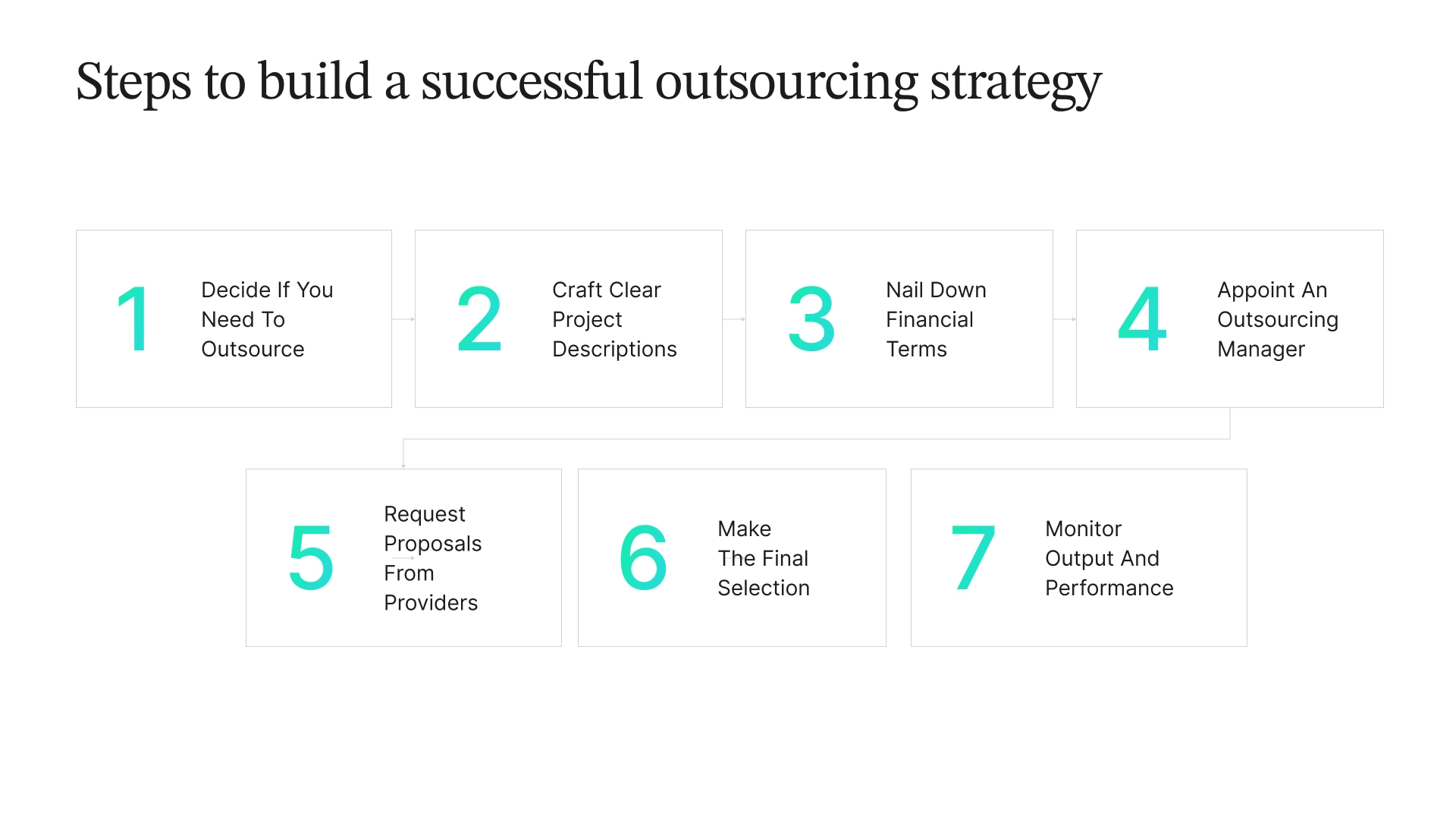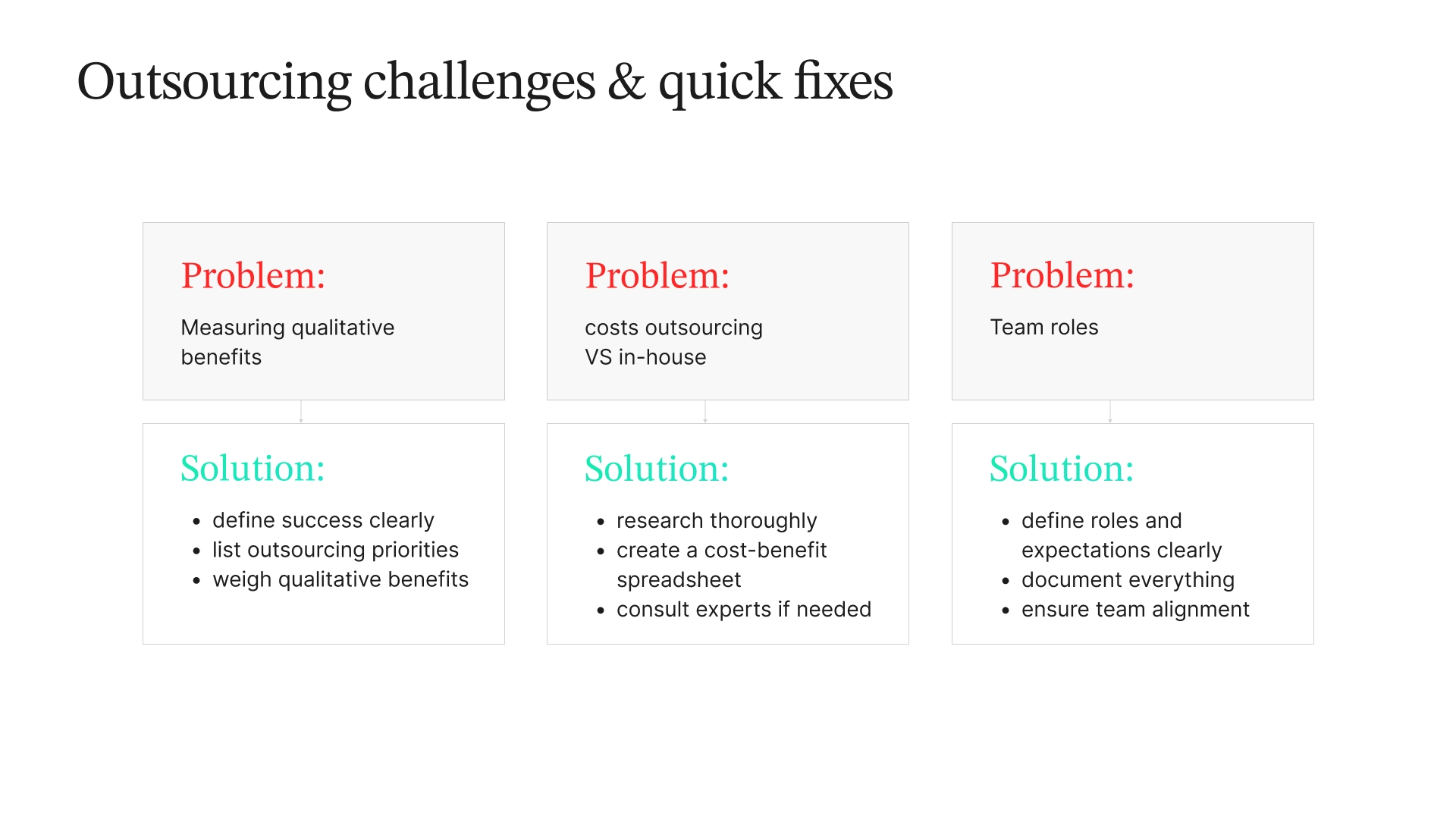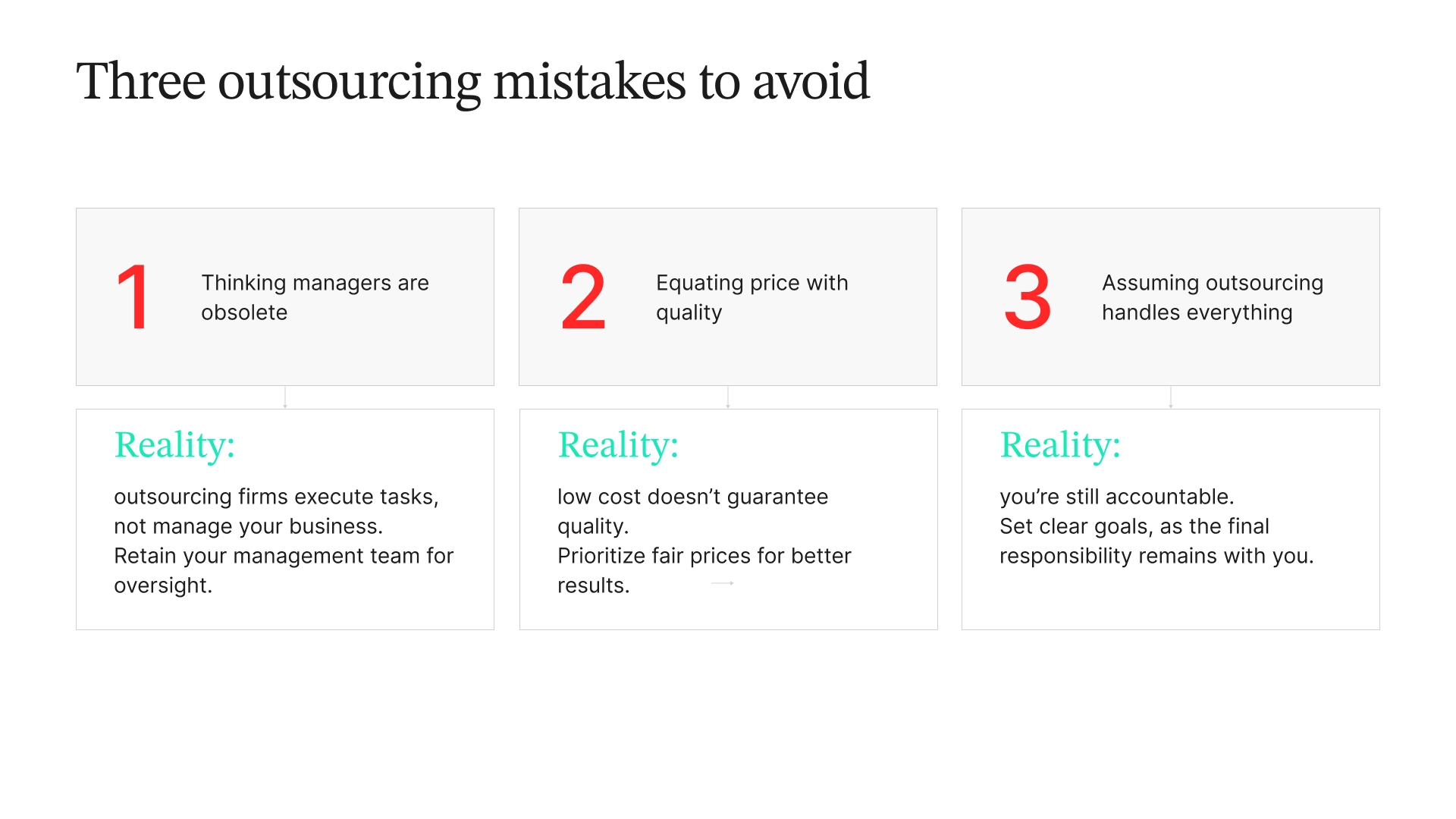Strange as it may seem, when some people think of business process outsourcing (BPO), they still picture just one thing—bustling call centers in far-off lands or those dreaded late-night customer service calls. But the thing is that outsourcing is so much more than that. It’s a powerful tool—or you can call it a secret weapon—that both small businesses and large corporations are skillfully wielding to improve business operations, cut costs, and delegate non-strategic functions to be able to focus on the big picture. And not only that. Outsourcing advantages do not narrow down to performing tedious, time-consuming, specific tasks that businesses have no time to deal with. Modern outsourcing is all about handling complex projects using unique expertise that internal teams usually lack. The fact that 57% of G2000 enterprises are outsourcing speaks volumes, doesn’t it?
But here’s the kicker: outsourcing is not just about offloading work; it’s about having a smart strategy to make the most out of it. It’s not simply a “nice-to-have” but rather a “must-have” in today’s hyper-competitive world. It’s like playing chess. Every move needs to be calculated to win the game. Without a solid outsourcing strategy, the process can turn into a wild goose chase—expensive, time-consuming, and ultimately ineffective. So, let’s find out how to outsource effectively.
What Is an Outsourcing Strategy?
If you were an architect drawing for a building, would you start construction without a blueprint? Exactly. An outsourcing strategy is your blueprint for all things outsourcing. In essence, it involves carefully identifying the tasks or processes that can be performed more efficiently or cost-effectively by external partners. It’s about striking that perfect balance between internal resources and external expertise.
But it’s not just about delegation. A successful outsourcing strategy also involves selecting the right partners, defining the scope of work, setting expectations, and establishing clear communication channels. At the end of the day, an effective outsourcing model is about adding value to your business, whether that means reducing costs, improving efficiency, or gaining access to specialized talent. It’s the behind-the-scenes process that can transform your business from good to great.
Why Do You Need an Outsourcing Strategy?
There are four basic types of outsourcing you can choose from or combine. Offshore outsourcing lets you tap into global talent and save on costs, while onshore outsourcing keeps operations close to home for better control and local expertise. Vertical outsourcing focuses on specific supply chain tasks, perfect for industries like product development. Whereas horizontal outsourcing handles non-core functions, such as IT support. With a well-crafted strategy for outsourcing, you’ll enjoy a plethora of benefits. Here are only a few of them.
Savings and savings again
One of the biggest perks of outsourcing is cost savings. If you outsource non-core activities to places where the labor force is cheaper, you can reduce your overhead faster than you can say “bottom line.” These funds can be reinvested in your organization to achieve your strategic goals and outpace competitors.
Access to unique expertise
No company can master everything. If you want to be a “Jack of all trades”, you can only be a master of none. Using a smart outsourcing strategy, you can gain access to qualified experts in different areas like software development, human resources, or accounting, you name it. Plus, you get global talent without the hassle of hiring full-time employees.
Increased efficiency
The very idea of outsourcing is improving efficiency. When you trust specific tasks that aren’t central to your business to an outsourced team, your in-house staff can finally do what they’re great at. Now you can expect from your internal team increased productivity, operational success, meeting all deadlines, and achieving all goals, because all the heavy lifting will be handled by your outsourcing partner.
Scalability in mind
Imagine your business booming, but hiring takes a lot of time. Outsourcing is your superhero, swooping in to save the day. It lets you scale operations quickly, adapting to market demands with flexibility. Whether launching a product or managing seasonal spikes, outsourcing gives you the agility to thrive. It’s like having a secret weapon in your business arsenal.
Focus on core business
Running a business can get bogged down with the daily grind, but your time and energy are limited. By outsourcing non-core activities, you free up resources to focus on what truly matters—your core objectives. This approach allows you to clear the clutter and concentrate on growth.
What Projects Can You Outsource?
Alright, let’s get practical. What kinds of projects can you outsource? Long story short—just about anything. Depending on the company size, industry, etc., there should be a tailored outsourcing business plan because outsourcing for startups and for enterprises might vary in scale. However, the core services remain pretty consistent.
IT Services
IT is the backbone of most businesses. However, not every company has the resources to build and maintain a full-scale IT department or develop web and mobile apps. It’s a common practice to outsource various tech services ranging from software development, AI, software engineering, network management etc.
Customer Support
Hardly any reputable company can do without customer support. It’s the main channel of communication with your customers, and the high quality of it is non-negotiable. Your customers will judge you by the support you provide to them. However, handling round-the-clock support, juggling time zone differences, can be a logistical nightmare. Outsourcing customer service to an experienced vendor can solve all your problems. Phone support, email, chat, or social media—omnichannel customer support is no longer something unusual—it’s a default outsourcing offering.
Digital Marketing
Marketing is essential to growing your business, but it’s also time-consuming and complex. From content marketing and social media management to SEO and paid advertising, marketing requires a diverse skill set that can be challenging to maintain in-house. Outsourcing this important function is a perfect solution.
Human Resources
HR is another area ripe for outsourcing. The key role of HR is to build a great workplace culture—attracting, retaining, and developing top talent. Such functions as recruitment, payroll processing, benefits administration, or employee training, HR functions can be time-consuming and require specialized knowledge, and can be outsourced.
Accounting and Finance
Let’s face it: numbers can be daunting. But they’re also crucial to the success of your business. Outsourcing accounting and finance tasks like bookkeeping, tax preparation, and financial analysis can save you time and ensure accuracy.
Seven Steps to Build a Successful Outsourcing Strategy
To fully benefit from BPO, you need to have a clear outsourcing plan. Here are several planning points to guide you.

Step 1. Decide if you need to outsource.
Outsourcing can be a game-changer, but it doesn’t suit everyone. To determine if it’s right for you, take a hard look at your internal departments. Are your teams hitting their marks? Are they aligning with your business goals? If productivity is lagging or results are subpar, it might be time to consider outsourcing. This could be the boost your organization needs to optimize business processes and get back on track.
Step 2. Craft clear project descriptions.
Once you’ve decided to take the outsourcing plunge, the next step is to come up with detailed project descriptions. They should outline the specific skills and expertise needed for success. For instance, if you’re outsourcing a marketing campaign, you’ll want pros who know their way around social media strategies. Clear project descriptions set the stage for smooth collaboration with third-party providers, helping you define your goals and expected outcomes right from the start.
Step 3. Nail down the financial terms.
When it comes to outsourcing, money is the name of the game, so it’s essential to set a strong financial foundation from the get-go. Start by establishing a clear project budget and deciding how payments will be structured—will it be tied to production, hours worked, or a per-project fee? Most seasoned outsourcing providers offer clear and transparent pricing models, so your task is to pick the one that fits your needs best. And here’s a pro tip: think about scalability. If your business starts booming, can your outsourcing company keep pace? It’s worth making sure they can grow with you.
Step 4. Appoint an outsourcing manager.
Even though outsourcing can lighten the load for your team, you’ll need a point person to watch deliverables and quality of performance. An outsourcing manager is your internal go-to for all things outsourcing. This person is the bridge between your company and the third-party provider, ensuring everyone is on the same page. With solid communication and project management skills, the outsourcing manager will be key in driving the success of the project. With solid communication and project resource management skills, the outsourcing manager will be key in driving the success of the project.
Step 5. Request proposals from the pros.
With your project description ready, it’s time to send out requests for proposals. This is where you’ll see who’s got what it takes to meet your business goals effectively and affordably. At this stage, you might want to interview potential contractors to get a better feel for how they can contribute to your organization and evaluate their project proposal in detail. Consider whether an offshore firm with lower rates or an onshore partner requiring closer collaboration is the best fit for your needs.
Step 6. Make the final selection.
It’s decision time. Choose the partner that best aligns with your organization’s goals, and then fine-tune the contract details. Keep in mind that finalizing the agreement might take up to a month, so patience is key. Pay close attention to every detail—security compliance, NDAs, equipment and software setup, tracking metrics, KPIs, and more. Each point is crucial because the contract is your safeguard, ensuring that your project runs smoothly and lives up to your expectations.
Step 7. Keeping an eye on output.
Once the outsourcing begins, don’t just set it and forget it. Monitor the output and gather feedback from your team to see if productivity is on the rise. Evaluate the quality of the work to ensure it meets your standards and complies with industry regulations. If any issues arise, your outsourcing manager should address them promptly to keep the project on track. If you stay vigilant, you can ensure that outsourcing delivers the results you need to hit those all-important key performance indicators.
Common Outsourcing Planning Problems & Solutions
There are a few challenges that seem to pop up over and over when creating an outsourcing project. Don’t let them deter you. Below are some quick solutions for common outsourcing planning problems.

Problem:
How do I measure the qualitative benefits of outsourcing, like “better access to expertise” or “more time to focus on core competencies?”
Solution:
Start by making two lists: one for your company’s priorities and another for the outsourcing goals. Then, figure out where the qualitative benefits align with these priorities and adjust your analysis accordingly. This is also the perfect time to get feedback from all stakeholders. It will help you assess potential outsourcing partners and guarantee quality assurance throughout the process.
Problem:
How do I compare, identify, and decide between the costs and benefits of outsourcing versus keeping the business process in-house?
Solution:
Do research. Get with your accountant and create a spreadsheet with all the measurable costs on both sides, weigh the qualitative costs according to your priorities, and keep all your formulas for costs at hand. If you are still unsure, this is the time to contact the experts in your network and get their input.
Problem:
My team is confused about their roles and expectations.
Solution:
Go back to the beginning and clearly define why you are choosing to outsource. Define the roles and responsibilities of each person involved. You need a document to reference all of the above, as well as the resources available for the project, the success terms, the milestones, and the type of outsourcing you will use.
Three Common Mistakes Businesses Make in Their Outsourcing Plan
Before using outsourcing in your company, it’s wise to learn from someone else’s mistakes than your own. We’re here to walk you through the most common blunders that businesses, especially smaller companies, tend to make when outsourcing. It is kind of a cheat sheet to avoid a few bumps in the road!

You will no longer need managers once you start working with an outsourcing firm.
It is a widespread mistake, which is an incomplete understanding of the role of outsourcing for your business. Outsourcing firm employees cannot take over your business and start managing it at the expense of their internal responsibilities and organization. The outsourcers of your tasks should not be handed over to you to manage, just as they cannot take some of your responsibilities to optimize the operation of your business. To fulfill the need to take care of personal matters regarding the organization and function of your business, it would make more sense to hire a management team.
Negotiated price and fair indemnification are the same.
Many business owners focus on the price category of the purchased services while ignoring other aspects, for example, their quality. However, it is undeniable that cheap does not mean profitable, and profitable does not mean cheap. When hiring an outsourcing company with democratic prices, do not expect that they will provide high-quality services. Regardless of the country or region, you have to provide your workers with the motivation to provide you with top-quality work. Speaking of fair compensation, which is higher than the market rate in outsourced work areas, will be reduced in your sphere.
Outsourcing should only be done for what you cannot do by yourself.
As a leader, you must understand all the minor details of your business, especially in organizational management. Many companies mistakenly believe that an outsourcing firm should do the work you assigned to them and be responsible for all management aspects. Even if you hand off about 100 percent of your activities, it is not your vendor that will face the results, but you. That is why it is always necessary to clearly and precisely formulate the goal of outsourcing to avoid such a global mistake.
Final Thoughts
When it comes to delegating certain functions to a third-party provider, many companies tend to focus on the risks of outsourcing, forgetting that there’s a whole world of benefits waiting on the other side. But let’s be real, outsourcing can be a game-changer for business owners. It’s a smart way to save valuable time and tap into the expertise of seasoned pros. In today’s business world, outsourcing is a necessity that helps you cut out inefficiencies and optimize your business activities. So, if you’re looking to create an effective outsourcing strategy, weigh the pros and cons of outsourcing and choose the right model. And one more thing—look no further than a reliable partner like Helpware to bring your business ambitions to life.













